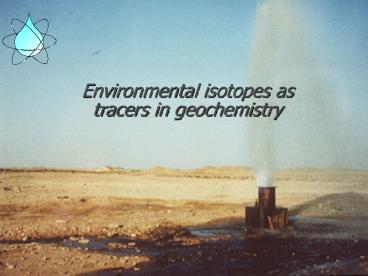Introduction to Environmental Isotopes - PowerPoint PPT Presentation
Title:
Introduction to Environmental Isotopes
Description:
Environmental isotopes as tracers in geochemistry Environmental Isotopes in Hydrogeology Introduction to the environmental isotopes Tracing the hydrologic cycle - 18O ... – PowerPoint PPT presentation
Number of Views:317
Avg rating:3.0/5.0
Title: Introduction to Environmental Isotopes
1
Environmental isotopes astracers in geochemistry
2
Environmental Isotopes in Hydrogeology
- Introduction to the environmental isotopes
- Tracing the hydrologic cycle - 18O, 2H, 13C
- Tracing mineral systems - 18O, 13C, 34S
3
Nucleosynthesis of the elements and isotopes
1H 1H ? 2H b v 2H 1H ? 3He g 4He 4He
? 8Be 8Be 4He ? 12C g 12C 1H ? 13C b v
g 13C 1H ? 14N g 14N 1H ? 15O g ? 15N
b v 12C 4He ? 16O 16O 2n ? 18O . . .
4
(No Transcript)
5
H2O
Oxygen
Isotopes
6
8 protons 10 neutrons
18O
18O
1
16O
500
7
The Common Stable Environmental Isotopes
Isotope Ratio natural Reference
(ratio) abundance 2H 2H/1H
0.015 VSMOW (0.00015575) 3He 3He/4He 0.000138
Atmospheric He (1.3E6) 13C 13C/12C 1.11 VPDB
(0.011237) 15N 15N/14N 0.367 AIR N2
(0.003677) 18O 18O/16O 0.204 VSMOW
(0.0020052) VPDB (0.0020672) 34S 34S/32S 4.21
CDT (0.045005) 37Cl 37Cl/35Cl 24.23 SMOC
(0.324)
8
Delta - permil d -
9
Delta - permil d -
VSMOW
10
What is the relative enrichment or depletion of
18O in crustal rocks (0.204) relative to
VSMOW
11
What is the relative enrichment or depletion of
18O in crustal rocks (0.204) relative to
VSMOW
12
What is the relative enrichment or depletion of
18O in crustal rocks (0.204) relative to
VSMOW
13
What is the relative enrichment or depletion of
18O in crustal rocks (0.204) relative to
VSMOW 17.4 VSMOW ?
crustal rocks are enriched in 18O by 17.4 or
1.7 relative to the standard VSMOW
14
Isotope Ratio Mass Spectrometry
15
Distribution of isotopes in nature
- Isotope fractionation during reaction
- Rayleigh distillation during reservoir depletion
- Mixing
16
Isotope fractionation, a
17
Physico-chemical fractionation
18
Physico-chemical fractionation
19
Physico-chemical fractionation
20
Physico-chemical fractionation
21
Isotope partitioning functions
? symmetry value m mass of isotope E the
energy state summed from the zero-point to
energy of the dissociated molecule (Jmole1) k
Boltzmann constant (gas constant per molecule)
n 1.380658 1023 JK1 T
thermodynamic temperature K
22
Units
- Isotope Enrichment (e)
- Isotope difference in permil units between two
reacting phases at equilibrium - when a is small, then we can use
23
- For a water vapor exchange at 25C
- what is the d18O of vapor, where
- water d18Ow 0.0 VSMOW
24
- For a water vapor exchange at 25C
- what is the d18O of vapor, where
- water d18Ow 0.0 VSMOW
- The fractionation factor (a) is
- a18Ow-v 1.0093
- The isotopic enrichment (e)
- e18Ow-v (a1) 103 9.3
- and e18Ov-w 9.3
25
- For a water vapor exchange at 25C
- what is the d18O of vapor, where
- water d18Ow 0.0 VSMOW
- e18Ow-v (a1) 103 9.3
- d18Ovapor d18Owater e18Owater-vapor
- 0.0 9.3
- 9.3
- vapor d18Ov 9.30 VSMOW
26
- For most reactions in geochemistry
- d values are typically 50 to 50
- a values are close to 1 (0.98 to 1.02)
- e values are typically 20 to 20
- Except for some extreme reactions and light
isotopes . . . - e.g. hydrogen gas produced from water is strongly
depleted in 2H and has a fractionation factor
a2HH2O-H2 3.76 at 25C.
27
Fractionation and Temperature
lnaX-Y aT2 bT1 c
28
Fractionation and Temperature
29
Fractionation - Other Systems































